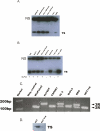Limits to thymidylate synthase and TP53 genes as predictive determinants for fluoropyrimidine sensitivity and further evidence for RNA-based toxicity as a major influence
- PMID: 19155291
- PMCID: PMC2887094
- DOI: 10.1158/0008-5472.CAN-08-3610
Limits to thymidylate synthase and TP53 genes as predictive determinants for fluoropyrimidine sensitivity and further evidence for RNA-based toxicity as a major influence
Abstract
The major determinants of 5-flurouracil (5-FU) response would seem, based on accumulated literature, to be thymidylate synthase (TYMS, TS) expression levels, TS gene modifications, and TP53 status. We tested 5-FU sensitivity in yeast and human cancer cell models in which TS or TP53 alleles and expression were varied. Polymorphic TS tandem repeat status, TS expression levels reported, TS intragenic mutations, and TP53 status in outbred and experimental cancer cell lines did not predict 5-FU sensitivity or resistance. Novel observations included a dose-resistant persistence of unbound TS protein in many cancers and, upon 5-FU treatment of the colon cancer cell line, HCT116, evidence of allelic switching favoring transcripts of the mutant TS allele. The reported alleles having an intragenic mutation could not be causally associated with major degrees of 5-FU sensitivity. In yeast, TS protein was altered upon treatment with FdUMP, but 5-FU toxicity seemed to be largely RNA-based, being rescued by uridine rather than by thymidine. Cancer cell lines were also rescued from 5-FU toxicity with uridine rather than thymidine. Additionally, a TS (CDC21) knockout yeast strain, obviating any potential role for TS protein as a target, was hypersensitive to 5-FU. When denatured proteins from cancer cells treated with radiolabeled 5-FU were labeled, species with alternative molecular weights other than TS were visualized, providing further evidence for alternative 5-FU protein targets. These data emphasize that TS and TP53 status do not consistently explain the variance in responses of fluoropyrimidine-treated cancer cells, in part due to RNA-based toxicity.
Figures




Similar articles
-
Polymorphic tandem repeat sequences of the thymidylate synthase gene correlates with cellular-based sensitivity to fluoropyrimidine antitumor agents.Cancer Chemother Pharmacol. 2005 Nov;56(5):465-72. doi: 10.1007/s00280-005-1018-z. Epub 2005 May 26. Cancer Chemother Pharmacol. 2005. PMID: 15918040
-
Chronic exposure of colorectal cancer cells in culture to fluoropyrimidine analogs induces thymidylate synthase and suppresses p53. A molecular explanation for the mechanism of 5-FU resistance.Anticancer Res. 2010 Apr;30(4):1149-56. Anticancer Res. 2010. PMID: 20530421
-
Mechanisms of acquired chemoresistance to 5-fluorouracil and tomudex: thymidylate synthase dependent and independent networks.Cancer Chemother Pharmacol. 2007 May;59(6):839-45. doi: 10.1007/s00280-006-0384-5. Epub 2006 Nov 22. Cancer Chemother Pharmacol. 2007. PMID: 17119966
-
Induction of thymidylate synthase as a 5-fluorouracil resistance mechanism.Biochim Biophys Acta. 2002 Jul 18;1587(2-3):194-205. doi: 10.1016/s0925-4439(02)00082-0. Biochim Biophys Acta. 2002. PMID: 12084461 Review.
-
Novel aspects of resistance to drugs targeted to dihydrofolate reductase and thymidylate synthase.Biochim Biophys Acta. 2002 Jul 18;1587(2-3):164-73. doi: 10.1016/s0925-4439(02)00079-0. Biochim Biophys Acta. 2002. PMID: 12084458 Review.
Cited by
-
Sarcosine Up-Regulates Expression of Genes Involved in Cell Cycle Progression of Metastatic Models of Prostate Cancer.PLoS One. 2016 Nov 8;11(11):e0165830. doi: 10.1371/journal.pone.0165830. eCollection 2016. PLoS One. 2016. Retraction in: PLoS One. 2022 May 19;17(5):e0268981. doi: 10.1371/journal.pone.0268981. PMID: 27824899 Free PMC article. Retracted.
-
Analysis of polymorphisms and haplotype structure of the human thymidylate synthase genetic region: a tool for pharmacogenetic studies.PLoS One. 2012;7(4):e34426. doi: 10.1371/journal.pone.0034426. Epub 2012 Apr 5. PLoS One. 2012. PMID: 22496803 Free PMC article.
-
Overexpression of thymidylate synthase (TYMS) is associated with aggressive tumor features and early PSA recurrence in prostate cancer.Oncotarget. 2015 Apr 10;6(10):8377-87. doi: 10.18632/oncotarget.3107. Oncotarget. 2015. PMID: 25762627 Free PMC article.
-
Pancreatic cancer.Lancet. 2011 Aug 13;378(9791):607-20. doi: 10.1016/S0140-6736(10)62307-0. Epub 2011 May 26. Lancet. 2011. PMID: 21620466 Free PMC article. Review.
-
Thymidylate synthase expression and p21(WAF1)/p53 phenotype of colon cancers identify patients who may benefit from 5-fluorouracil based therapy.Cell Oncol (Dordr). 2014 Feb;37(1):17-28. doi: 10.1007/s13402-013-0159-z. Epub 2013 Nov 26. Cell Oncol (Dordr). 2014. PMID: 24277474 Free PMC article.
References
-
- Heidelberger C, Chaudhuri NK, Dannenberg P, et al. Fluorinated pyrimidines: A new class of tumour inhibitory compounds. Nature. 1957;179:663–6. - PubMed
-
- Longley DB, Harkin DP, Johnston PG. 5-Flurouracil: Mechanisms of action and clinical strategies. Nature Rev Cancer. 2003;3:330–8. - PubMed
-
- Noordhuis P, Holwerda U, Van der Wilt CL, et al. 5-Fluorouracil incorporation into RNA and DNA in relation to thymidylate synthase inhibition of human colorectal cancers. Ann Oncol. 2004;15:1025–32. - PubMed
-
- Santi DV, McHenry CS, Sommer H. Mechanism of interaction of thymidylate synthestase with 5-fluorodeoxyuridylate. Biochemistry. 1974;13:471–81. - PubMed
MeSH terms
Substances
Grants and funding
LinkOut - more resources
Full Text Sources
Molecular Biology Databases
Research Materials
Miscellaneous

